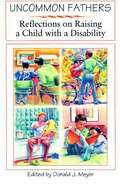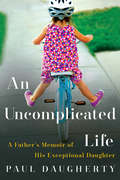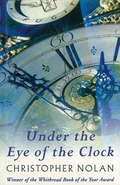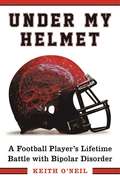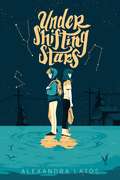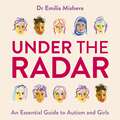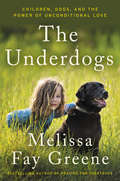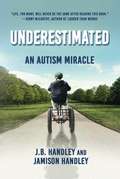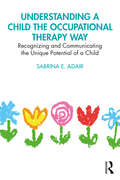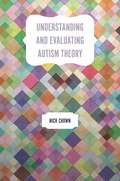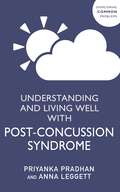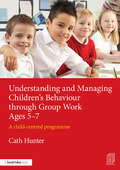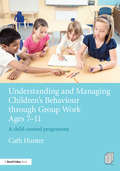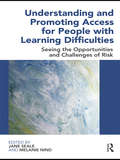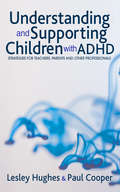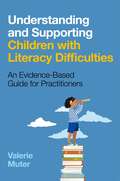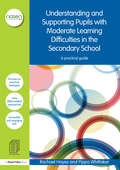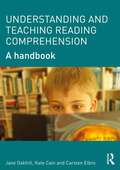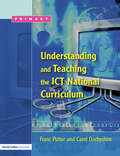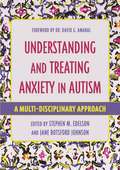- Table View
- List View
Uncharted: How Scientists Navigate Their Own Health, Research, and Experiences of Bias
by Skylar Bayer Gabriela Serrato MarksPeople with disabilities are underrepresented in STEM fields, and all too often, they face isolation and ableism in academia. Uncharted is a collection of powerful first-person stories by current and former scientists with disabilities or chronic conditions who have faced changes in their careers, including both successes and challenges, because of their health. It gives voice to common experiences that are frequently overlooked or left unspoken. These deeply personal accounts describe not only health challenges but also the joys, sorrows, humor, and wonder of science and scientists.With a breadth of perspectives on being disabled or chronically ill, these stories highlight the intersectionality of minoritized identities with the disability community. Uncharted features essays by contributors who are d/Deaf, blind, neurodivergent, wheelchair users, have experienced traumatic brain injuries, have blood sugar disorders, have rare medical diagnoses, or have received psychiatric diagnoses, among many others. In many cases, the scientific field is not fully accessible to them, and they frankly describe struggling as well as thriving alongside their conditions.This book serves as representation for scientists who have never felt comfortable disclosing their disability or who have never felt fully understood. The stories shared in this book seek to normalize medical conditions and disabilities in scientific culture, offering recommendations for how and why to improve access. Uncharted is vital and compelling reading for current and aspiring scientists who want to make their fields more inclusive and supportive for everyone.
Uncommon Fathers: Reflections on Raising a Child with a Disability
by Donald J. MeyerUncommon Fathers is a compelling collection of essays by fathers who were asked to reflect and write about the life-altering experience of having a child with a disability. Nineteen fathers have taken an introspective and honest look at this deeply emotional subject, offering a seldom-heard perspective on raising children with special needs. (from the publisher)
An Uncommon Gift
by James S. EvansThe following quote is taken from the side flaps of the book: "Jamie Evans knows the meaning of fear, but it is not a posture he accepts himself. Like millions of Americans, he suffers from dyslexia and hyperkinesia. In this remarkable story of his struggle to combat these difficulties, he meets obstacle after obstacle and knocks them down, one by one. He reveals what is going on inside the person who cannot sit still, who is frustrated by an inability to read, who stutters, whose behavior is generally disruptive. The son of Dr. Louis H. Evans, Jr., and Colleen Townsend Evans, Jamie was born into a nurturing family who offered him love and provided excellent educational opportunities. Still, he had to fight a lonely battle. Beyond academic problems, Jamie experienced a lack of esteem and self-love. He was an angry, controlling person. In AN UNCOMMON GIFT Jamie relates how he conquered his learning disabilities. He shows that through counseling and supportive relationships deep emotional scars began to heal. From an individual who demanded constant attention emerged a caring person who recognizes the special needs of others. This is also a story of enduring faith. The author believes that God would not have given him problems without providing the resources to cope with them. He describes experiencing the power of Christ, who remained with him during a healing process that went on for years. Forthright, compelling, fascinating to read, this story of a young man's inner and outer struggles and ultimate victory carries a special message for all those who face life with handicaps to overcome, as well as for the families and friends who stand with them."
An Uncomplicated Life
by Paul DaughertyA father's exhilarating and inspiring love letter to his daughter with Down syndrome, whose vibrant and infectious approach can teach us all how to live a little better"Jillian was born October 17, 1989. It was the last bad day."Jillian Daugherty was born with Down syndrome. The day her parents, Paul and Kerry, brought her home from the hospital, they were flooded with worry and uncertainty, but also with overwhelming love, which they channeled to "the job of building the better Jillian." They knew their daughter had special needs, but they refused to have her grow up needy. They were resolved that Jillian's potential would not be limited by preconceptions of who she was or what she could be.In this charming and often heart-stirring book, Paul tells stories about Jillian making her way through the world of her backyard and neighborhood, going to school in a "normal" classroom, learning to play soccer and ride a bike. As she grows older, he traces her journey to find happiness and purpose in her adult life, including vignettes about her inspiring triumphs and the guardian angels--teachers, neighbors, friends--who believed in Jillian and helped her become the exceptional young woman she is today.In An Uncomplicated Life, the parent learns as much about life from the child as the child does from the parent. Being with Jillian, Paul discovered the importance of every moment and the power of the human spirit--how we are each put here to benefit the other. Through her unmitigated love for others, her sparkling charisma, and her boundless capacity for joy, Jillian has inspired those around her to live better and more fully. As Paul writes, "Jillian is a soul map of our best intentions," a model of grace, happiness, and infectious enthusiasm. She embraces all that she is, all that she has--"I love my life. I just love my life," she says. In her uncomplicated life, we see the possibility, the hope, and the beauty of our own.
Undaunted by Blindness
by Clifford E. OlstromThe purpose of this book is to provide concise biographical information about four hundred notable blind persons. The people in this volume are but a small sample of the many thousands of notable blind persons in history.
Under The Eye Of The Clock: A Memoir
by Christopher NolanA powerful and moving autobiography from a gifted writer who has been compared to Joyce and Yeats.This is the story of Joseph Meehan, born cruelly handicapped and known to the world as 'the crippled boy'. Filled with insight into the soul inside a broken body and warm with the beauties of the Irish landscape it is the story of Joseph's fight to escape the restrictions and confines of his existence.UNDER THE EYE OF THE CLOCK can also be read as the autobiography of its author, Christopher Nolan.
Under The Eye Of The Clock
by Christopher NolanA powerful and moving autobiography from a gifted writer who has been compared to Joyce and Yeats.'A book of sheer wonder. As an author he competes as an equal with the ablest of them' DAILY EXPRESSThis is the story of Joseph Meehan, born cruelly handicapped and known to the world as 'the crippled boy'. Filled with insight into the soul inside a broken body and warm with the beauties of the Irish landscape it is the story of Joseph's fight to escape the restrictions and confines of his existence.UNDER THE EYE OF THE CLOCK can also be read as the autobiography of its author, Christopher Nolan.
Under My Helmet: A Football Player’s Lifelong Battle with Bipolar Disorder
by Tony Dungy Keith O'NeilEver since he was a child, Keith O’Neil wanted to play football. Born on the same day that his father, Ed O’Neil, was cut from the New England Patriots, football was all Keith could think about . . .aside from his anxiety. Offered a scholarship to Northern Arizona University, O’Neil jumped at the chance to prove himself. Though it wasn’t a Division I-A school, he brought his all and was a natural on the field, achieving first-team All-Big Sky choice as a junior and senior, as well as earning All-American honors. Going undrafted, luck came from the Dallas Cowboys, who offered O’Neil an invite to rookie mini-camp. But while trying to learn the playbook, his anxiety and insomnia returned. Even so, he made the team as an undrafted free agent. His dream had come true. While proving himself as a hard-nosed special teamer, sleepless nights, constant anxiety, and suicidal thoughts clouded his mind. O’Neil considered stepping away from the game multiple times, even speaking to his coach, Bill Parcells. Parcells gave him the wisdom that ?Everyone has a demon in their head, and we have to beat that demon. Beat the demon!” After being released from the Cowboys, O’Neil spent time with the Colts and Giants, but still could not escape his inner demons. He asked for help but never received the attention he needed. In fact, for suicidal thoughts was given a CD to help him relax?Enya. It finally became too much for him to handle, and the final decision was made to walk away from the game. It wasn’t until sometime later that was finally diagnosed: Bipolar I disorder. Finally, everything made sense.Under My Helmet is the personal story of a man working every day to prove his worth while struggling with a debilitating?and undiagnosed?mental illness. O’Neil’s voice is honest and open as he shares his battles and the steps he’s taken to overcome adversity.
Under Shifting Stars
by Alexandra LatosThis heartfelt novel for fans of Jandy Nelson and Adam Silvera follows twins Audrey and Clare as they grapple with their brother's death and their changing relationships-with each other and themselves. Audrey&’s best friend was always her twin, Clare. But as they got older, they grew apart, and when their brother Adam died, Clare blamed Audrey for the accident. Now, Audrey&’s attending an alternative school where she feels more isolated than ever. Tired of being seen as different from her neurotypical peers, Audrey&’s determined to switch to the public high school, rebuild her friendship with Clare, and atone for Adam&’s death . . . but she&’ll need to convince her parents, and her therapist, first. Clare knows her sister thinks she&’s the perfect twin, but Audrey doesn&’t realize that Clare&’s &“popular&” status is crumbling—she&’s begun to question old friendships, dress in Adam&’s clothes, and wonder what feelings for a nonbinary classmate, Taylor, might mean. As she grapples with not only grief but also her gender fluidity, Clare wonders where she&’ll belong if she sheds her carefully constructed image and embraces her true self. Will first crushes, new family dynamics, and questions of identity prove that Audrey and Clare have grown too different to understand each other-or that they've needed each other all along?
Under the Radar: An Essential Guide to Autism and Girls
by Emilia MishevaWhat is the first thing that comes to your mind when you think of autism? Often, it's a boy who struggles with friendships, but who loves trains and is great at maths. While this may reflect the experiences of some autistic people, in recent years research and first-hand accounts have shown that many others don't conform to this image. The historical perception of autism as a "male condition" as well as simplistic stereotypes have led to an under-identification of autism in some girls and women - and, indeed, in all people, regardless of gender, who do not fit this mould.This straightforward, one-stop guide introduces you to the differing presentations of autism that are common in girls, but also explores why referring to 'male' and 'female' autism is too reductive. Describing why some autistic girls' needs are identified late or not at all, looking at friendships and relationships, education, mental health and puberty, this concise, easy-to-understand and informative book draws on both lived experience and research to offer a popular science overview of this important topic.
The Underdogs: Children, Dogs, and the Power of Unconditional Love
by Melissa Fay GreeneFrom two-time National Book Award nominee Melissa Fay Greene comes a profound and surprising account of dogs on the front lines of rescuing both children and adults from the trenches of grief, emotional, physical, and cognitive disability, and post-traumatic stress disorder.The Underdogs tells the story of Karen Shirk, felled at age twenty-four by a neuromuscular disease and facing life as a ventilator-dependent, immobile patient, who was turned down by every service dog agency in the country because she was "too disabled." Her nurse encouraged her to tone down the suicidal thoughts, find a puppy, and raise her own service dog. Karen did this, and Ben, a German shepherd, dragged her back into life. "How many people are stranded like I was," she wondered, "who would lead productive lives if only they had a dog?"A thousand state-of-the-art dogs later, Karen Shirk's service dog academy, 4 Paws for Ability, is restoring broken children and their families to life. Long shunned by scientists as a manmade, synthetic species, and oft- referred to as "Man's Best Friend" almost patronizingly, dogs are finally paid respectful attention by a new generation of neuroscientists and animal behaviorists. Melissa Fay Greene weaves the latest scientific discoveries about our co-evolution with dogs with Karen's story and a few exquisitely rendered stories of suffering children and their heartbroken families.Written with characteristic insight, humanity, humor, and irrepressible joy, what could have been merely touching is a penetrating, compassionate exploration of larger questions: about our attachment to dogs, what constitutes a productive life, and what can be accomplished with unconditional love.
Underestimated: An Autism Miracle (Children’s Health Defense)
by J. B. Handley Jamison HandleyThe incredibly moving and inspiring story about a quest to finally be heard.In Underestimated: An Autism Miracle, Generation Rescue&’s cofounder J.B. Handley and his teenage son Jamison tell the remarkable story of Jamison&’s journey to find a method of communication that allowed him to show the world that he was a brilliant, wise, generous, and complex individual who had been misunderstood and underestimated by everyone in his life. Jamison&’s emergence at the age of seventeen from his self-described &“prison of silence&” took place over a profoundly emotional and dramatic twelve-month period that is retold from his father&’s perspective. The book reads like a spy thriller while allowing the reader to share in the complex emotions of both exhilaration and anguish that accompany Jamison&’s journey for him and his family. Once Jamison&’s extraordinary story has been told, Jamison takes over the narrative to share the story from his perspective, allowing the world to hear from someone who many had dismissed and cast aside as incapable.Jamison&’s remarkable transformation challenges the conventional wisdom surrounding autism, a disability impacting 1 in 36 Americans. Many scientists still consider nonspeakers with autism—a full 40 percent of those on the autism spectrum—to be &“mentally retarded.&” Is it possible that the experts are wrong about several million people? Are all the nonspeakers like Jamison? Underestimated: An Autism Miracle will touch your heart, inspire you, remind you of the power of love, and ultimately leave you asking tough questions about how many more Jamisons might be waiting for their chance to be freed from their prison of silence, too. And, for the millions of parents of children with autism, the book offers a detailed description of a communication method that may give millions of people with autism back their voice.
Understanding a Child the Occupational Therapy Way: Recognizing and Communicating the Unique Potential of a Child
by Sabrina E. AdairThis book uses an occupational therapy way of thinking to guide the reader towards observing, understanding, and communicating the needs of children to foster a supportive environment. Presented in accessible, everyday language, this book takes a holistic approach of looking at a child from what makes them a unique person, what activities they are trying to accomplish, and what environment they are in. Each chapter helps readers identify, describe, and clearly articulate a different aspect of the child’s environment and how it may affect them, the way that they process different sensory inputs, what their behaviors may be telling us, and how they learn. By recognizing each child’s unique story and effectively communicating their story to others, the reader can identify the most effective ways to support a child to meet a child’s needs and set them up for success. Therapists, educators, parents, and childcare workers will all benefit from the simple strategies outlined in this book to enrich a child’s learning.
Understanding and Evaluating Autism Theory
by Nick ChownAddressing the full spectrum of theoretical output associated with autism and Asperger syndrome, this is the complete guide to autism theory - spanning from mainstream and alternative, through to non-autism specific theories that might be applied to autism. Previous study on autism has made significant inroads into the individual branches of autism theory, however, no text has brought together the complete range of theories in an accessible textbook for students and academics. The author argues that a more obvious application of theory to autism intervention would be beneficial to practitioners. With access to the complete range of available autism and Asperger syndrome theory, from development theories to learning style theories, the academics and students working towards the practical application of theory to intervention will have all the necessary information at their disposal. The book is based on a series of autism theory lectures delivered for the NAS and Sheffield Hallam University.
Understanding and Living Well With Post-Concussion Syndrome
by Priyanka Pradhan Anna LeggettConcussion, even in its mildest form, can have lasting effects on the individual in a way we're only just beginning to understand. Mild Traumatic Brain Injuries (mTBI), concussion and post-concussion syndrome have previously been conservatively managed with recommendations for 'rest'. But even mild brain injuries and post-concussion syndrome can have an enormous impact on life, long after the 3 months during which they are expected to resolve. There are also significant differences between the way in which concussion affects men and women respectively, as this new research shows. If concussion or an mTBI are affecting you, there is much in this book to help and support your symptoms. Neuropsychologist Dr Priyanka Pradhan has pulled together the latest research to provide a complete manual for overcoming the impact of any mild brain injury, while writer and coach Anna Leggett gives deep insight from her own experiences with post-concussion syndrome. Their book not only explains what a concussion is and how it may present, but also gives comprehensive practical strategies for managing persistent symptoms. Such strategies include how to ask for professional and specialist medical help (and where to get it from), and also self-management techniques that draw on things like EMDR, craniosacral therapy and osteopathy. Understanding and Living Well with Post-Concussion Syndrome also explains the importance of sleep and diet, and includes significant psychological and emotional support for mental wellbeing and recovery, a support that is often missing from the clinical pathway for post-concussion syndrome. This book is an essential resource for anyone who feels that they need insight, practical help and emotional support into what is often perceived as an almost-invisible illness, but one which is very real for you or your loved one.
Understanding and Living Well With Post-Concussion Syndrome
by Priyanka Pradhan Anna LeggettConcussion, even in its mildest form, can have lasting effects on the individual in a way we're only just beginning to understand. Mild Traumatic Brain Injuries (mTBI), concussion and post-concussion syndrome have previously been conservatively managed with recommendations for 'rest'. But even mild brain injuries and post-concussion syndrome can have an enormous impact on life, long after the 3 months during which they are expected to resolve. There are also significant differences between the way in which concussion affects men and women respectively, as this new research shows. If concussion or an mTBI are affecting you, there is much in this book to help and support your symptoms. Neuropsychologist Dr Priyanka Pradhan has pulled together the latest research to provide a complete manual for overcoming the impact of any mild brain injury, while writer and coach Anna Leggett gives deep insight from her own experiences with post-concussion syndrome. Their book not only explains what a concussion is and how it may present, but also gives comprehensive practical strategies for managing persistent symptoms. Such strategies include how to ask for professional and specialist medical help (and where to get it from), and also self-management techniques that draw on things like EMDR, craniosacral therapy and osteopathy. Understanding and Living Well with Post-Concussion Syndrome also explains the importance of sleep and diet, and includes significant psychological and emotional support for mental wellbeing and recovery, a support that is often missing from the clinical pathway for post-concussion syndrome. This book is an essential resource for anyone who feels that they need insight, practical help and emotional support into what is often perceived as an almost-invisible illness, but one which is very real for you or your loved one.
Understanding and Managing Children's Behaviour through Group Work Ages 5-7: A child-centred programme
by Cath HunterUnderstanding and Managing Children’s Behaviour 5-7 provides the reader with an insight into children’s emotional well-being and helps them to understand what and how children communicate and how to respond in a way that provides positive messages, increases their emotional vocabulary and encourages them to change their behaviour. It provides an alternative and effective child-centred way of managing children’s behaviour through introducing the concept of reflective language and other tools, equipping staff with new skills that are transferable across the school in any role. The book is divided into two sections, enabling the reader to link theory with practice. The first section takes the reader on a journey to help them understand the different factors that influence children’s behaviour. The second section of the book focuses on the group work programmes, how they can be used, their value and the impact they can have on children and the school as a whole. The activities in the group work programmes explore the concept of using reflective language as a behaviour management tool and are designed to motivate and build confidence, self-esteem and resilience. Useful pedagogical features throughout the book include: practitioner and classroom management tips and reflective tasks; strategies and practical ideas for staff to use to help them engage more deeply with the contents of the book; flexible, tried and tested group work programmes designed to promote inclusion rather than exclusion; clear step-by-step instructions for delivering the group work programmes; case studies showing behaviour examples with detailed explanations for the behaviour and strategies to respond to it. This book is aimed at all KS1 primary school staff, especially teaching assistants, learning mentors and family workers who can deliver the group work programmes. It is also recommended reading for SENCOs and trainee teachers, and will be useful for therapists who work with children and are looking at delivering other approaches in their work.
Understanding and Managing Children's Behaviour through Group Work Ages 7 - 11: A child-centred programme
by Cath Hunter'I would highly recommend the skills, expertise and delivery that Cath can bring to a school and can guarantee that any school following her advice will not regret it.' Carl McIver, Head of School, St. Willibrord's R.C. Primary, Manchester 'I have worked with Cath Hunter now in two schools and find that the work she does with children, parents and staff is amazing.' Sam Foord, Headteacher, Ravensbury Community School, Manchester Understanding and Managing Children’s Behaviour provides the reader with an insight into children’s emotional wellbeing and helps them to understand what and how children communicate and how to respond in a way that provides positive messages, increases their emotional vocabulary and encourages them to change their behaviour. It provides an alternative and effective child centred way of managing children’s behaviour through introducing the concept of reflective language and other tools, equipping staff with new skills that are transferable across the school in any role. The book is divided into two sections, enabling the reader to link theory with practice. The first section takes the reader on a journey to help them understand the different factors that influence children’s behaviour. The second section of the book focuses on the group work programmes, how they can be used, their value and the impact they can have on children and the school as a whole. The activities in the group work programme explore the concept of using reflective language as a behaviour management tool and are designed to motivate, build confidence, self-esteem and resilience. Useful pedagogical features throughout the book include:- Practitioner and classroom management tips and reflective tasks; Strategies and practical ideas for staff to use to help them engage more deeply with the contents of the book; Flexible, tried and tested group work programmes designed to promote inclusion rather than exclusion; Clear step by step instructions for delivering the work programmes; Case studies showing behaviour examples with detailed explanations for the behaviour and strategies to respond to it. The book is aimed at all primary school staff, especially teaching assistants, learning mentors and family workers who can deliver the group work programmes. It is also recommended reading for SENCOs and trainee teachers and will also be useful for therapists who work with children and are looking at delivering other approaches in their work.
Understanding and Promoting Access for People with Learning Difficulties: Seeing the Opportunities and Challenges of Risk
by Jane Seale Melanie NindThe issue of access is at the forefront of the practical challenges facing people with learning difficulties and people working with or supporting them. This engaging text brings together evidence, narratives and discussions that question and advance our understanding of the concept of access for people with learning difficulties. Seale and Nind draw on their expertise to analyse a wide range of situations, including access to public spaces, citizenship education, community participation, and employment. Through a series of related chapters, key researchers in the field of inclusion and learning difficulties enrich the access debate by: considering what kind of access people with learning difficulties want; identifying effective practice in relation to facilitating and promoting access; revealing the capability of people with learning difficulties to seek and achieve access to potentially exclusionary communities; providing a space for a wide range of people to share access stories. With contributions from a variety of stakeholders including people with learning difficulties, Understanding and Promoting Access for People with Learning Difficulties clarifies the concept of access without over-simplifying what is involved. Through rigorous critique, this book provides a unique rationale for a new multi-dimensional model of access and ways of promoting it. Proposing a reconceptualisation of the risk associated with promoting access for people with learning difficulties, this book will be of immense interest to students, researchers and professionals involved in inclusion and disability issues.
Understanding and Supporting Children with ADHD: Strategies for Teachers, Parents and Other Professionals
by Lesley A Hughes Paul W Cooper′This book provides a succinct overview of issues relevant to understanding and supporting pupils with ADHD. It is well written and includes authentic case studies... The real strength of the book is in its careful consideration of how collaborative working can enable youngsters with an ADHD diagnosis to get the best out of their education. Ideas outlined are practical but are also based on careful thinking about effective models and approaches to intervention... an excellent starting point for anyone embarking on research related to educational provision for pupils with ADHD′ - SENCO Update ′In many ways this publication reads like a toolkit, and as such offers a range of practices that may be considered in order to improve outcomes for all. A readable and supportive book′ - SNIP Children with Attention Deficit Hyperactivity Disorder (ADHD) can be hard to include in a mainstream classroom, and managing their behaviour is often a challenge. Drawing directly from real classroom experience, this book shows how to use effective management strategies to improve behaviour in the classroom and at home. This interdisciplinary approach will provide teachers with: " strategies to deal with disruptive behaviours " ways to channel children′s positive characteristics " advice on how teachers can support and guide parents " behaviour management techniques to promote positive behaviour " advice on collaborative working, and how teachers can build partnerships with other professionals.
Understanding and Supporting Children with Literacy Difficulties: An Evidence-Based Guide for Practitioners
by Valerie MuterLearning to read is arguably the single most important educational challenge a child faces in the first years of schooling, setting a child up for future academic success and opportunities. However, it is estimated that one in six children experience literacy difficulties. This is the go-to book for psychologists, educationalists and other professionals wanting a deeper understanding of current thinking around dyslexia, reading comprehension difficulties, and related SpLDs. Drawing on six fictional case studies to illustrate her points, and using examples of good practice throughout, Valerie Muter unpacks the latest psychological theories and research on literacy disorders. She discusses the interconnections between underlying cognitive problems and learning and educational and behavioural issues, as well as the common co-occurrence of these conditions. This authoritative book also provides accessible guidance on making assessments and tailoring interventions within the home or school.Written by a lead thinker in the field, this is an essential evidence-based guide for those working with children with literacy difficulties and supporting them to achieve their full potential.
Understanding and Supporting Pupils with Moderate Learning Difficulties in the Secondary School: A practical guide (nasen spotlight)
by Rachael Hayes Pippa WhittakerAre you working with students who have Moderate Learning Difficulties? Do you want to know how best to help them? Are you confused about what helps and what hinders? Learners with MLD form one of the largest categories of special educational need in mainstream secondary schools. In most schools, the vast majority of learners with MLD will be taught in mainstream classes much of the time. This book outlines a range of strategies and approaches for supporting these learners. It includes all the vital information practitioners need to know about Moderate Learning Difficulties. Key points covered include: Definitions and identification of moderate learning difficulties Teaching strategies and approaches Developing key conceptual, literacy and social skills Effective support from TAs Theoretical perspectives on learning Understanding and Supporting Pupils with Moderate Learning Difficulties in the Secondary School provides an introduction to a wide range of ideas, arguments and perspectives about ways of understanding and supporting learners who are considered to have MLD. This is a much-needed source of knowledge for teachers, TAs, SENCos, Learning Mentors and anyone who supports children and young people with moderate learning difficulties and provides an honest and accessible approach.
Understanding and Teaching Reading Comprehension: A handbook
by Jane Oakhill Kate Cain Carsten ElbroThe ultimate aim of reading is not the process but to understand what we read and comprehension can take place at many different levels. There has been an increasing emphasis on the importance of reading comprehension in recent years but despite this there is very little written on this vital topic accessible to trainee and practicing teachers. The Handbook of Reading Comprehension presents an overview of recent findings on reading comprehension and comprehension problems in children. It provides a detailed examination of the characteristics of children who have reading comprehension difficulties, and examines ways in which comprehension can be supported and improved. It is accessibly written for students and professionals with no previous background in the psychology of reading or reading problems. This indispensable handbook asks the question ‘what is comprehension?’ The authors consider comprehension of different units of language: understanding single words, sentences, and connected prose and outline what readers (and listeners) have to do to successfully understand an extended text. This book also considers comprehension for different purposes, in particular reading for pleasure and reading to learn and explores how reader characteristics such as interest and motivation can influence the comprehension process. Different skills contribute to successful reading comprehension. These include word reading ability, vocabulary knowledge, syntactic skills, memory, and discourse level skills such as the ability to make inferences, knowledge about text structure, and metacognitive skills. The authors discuss how each one contributes to the development of reading comprehension skill and how the development of these skills (or their precursors) in pre-readers, provides the foundation for reading comprehension development. Areas covered include:- Word reading and comprehension Development of comprehension skills Comprehension difficulties Assessment Teaching for improvement Throughout the text successful experimental and classroom based interventions will be highlighted, practical tips for teachers and summary boxes detailing key points and explaining technical terms will be included in each chapter
Understanding and Teaching the ICT National Curriculum
by Franc PotterThere is still great uncertainty in the teaching profession regarding the effective delivery of ICT. This introductory book provides both trainee and practising teachers with a clear understanding of the ICT National Curriculum and how to teach it. Combining extensive practical advice with a critical discussion of the key theoretical issues, the book will help teachers develop their pupil's true ICT capability through clear explanations of the Programmes of Study, full guidance on using QCA Scheme of Work, different and creative ideas for delivering the ICT National Curriculum, and the confidence and ability to go beyond the QCA Sceme of Work for ICT.
Understanding and Treating Anxiety in Autism: A Multi-Disciplinary Approach
by Stephen M. Edelson and Jane Botsford JohnsonAnxiety is a prevalent and often debilitating condition for individuals on the autism spectrum. This book promotes a multidisciplinary approach to intervention and treatment of the condition, providing professional understanding of the underlying causes and available treatments. With chapters co-authored by well-known advocates and pioneering researchers, contributors examine factors including sensory processing issues, sleep impairments and the crossover between the autonomic nervous system and immune system. The book expands upon current areas of research, including immune activation and the role of environmental toxicants, dietary and nutritional support, the treatment of gastrointestinal disorders and individualised methods of managing stress and anxiety. Providing an invaluable resource for professionals and academics seeking further insight into anxiety and autism, this book explores contemporary research and sets the groundwork for the most effective methods of treatment for individuals of all ages.

